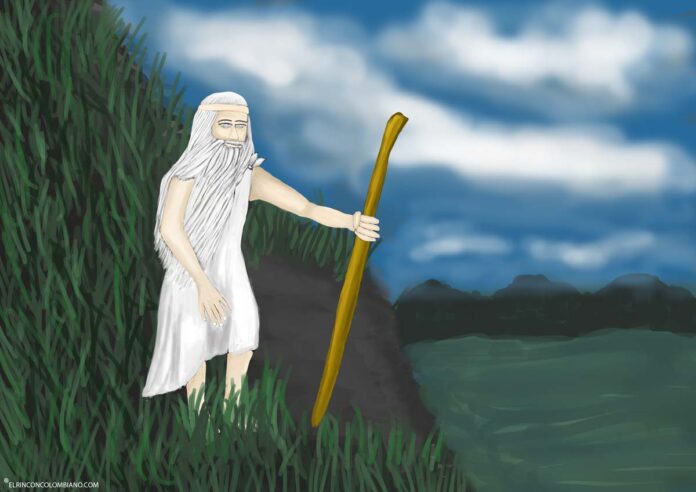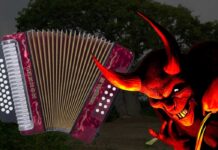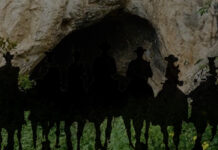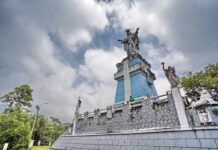The Bochica myth tells the story of a civilizing god or hero who gave the people muisca knowledge and knowledge that allowed it to advance as a society, some of that knowledge was: Learning to plant, spin cotton, ethical and moral values, among others.
Bochica myth
According to the myth, around 1,500 to 2,000 years before the arrival of the Spanish to America, he arrived at the Muisca empire a strange man never seen before in these lands, it is said that he arrived from the East, through the eastern plains and entered these lands through the town of Easter.
From there he came to the town of Bosa where a camel he was carrying died, whose bones the indigenous people of the place preserved, for the purpose of worshiping them. From Bosa he went to the town of Yntyba (Hontibón), at Funza (Bogotá), Sagasuca (Serrezuela) and Zipacón, opening roads until reaching the town of Cota. This tour was in what was known as the Bataca province. In the provinces of Guane, Hunza and Suamox visited: Toyú, Guane, Hunza, Otga, Suamox (Sogamoso) and Iza.
(Read Also: Myth of Bachué: The progenitor goddess of humanity)
It is said that this man had the appearance of an old man with a very long beard that reached almost to his waist, his hair was gray and tied with a ribbon. Wearing a almalafa or white cloak that covered his body up to his feet and that had a knot tied over the shoulder, he also carried a golden rod, staff or staff and also walked with bare feet.
This man left teachings and knowledge for each town he passed through. It is said that he taught the indigenous people how to plant crops, how to spin cotton, and weave blankets; since before the arrival of this being, the indigenous people dressed with sheets of raw cotton tied with cords of cotton. fique.
It is also said that where Bochica passed, the roads were opened and the mountains were leveled, giving rise to many of the roads that the Muiscas owned before the arrival of the Spanish.
(Read Also: Legend of the Cucacuy)
It is said that he preached good things and that he preached in their own language to each town, with which they were amazed. Among the teachings he preached were the resurrection of the flesh, giving alms, not stealing, not killing, among many others.
Every preaching he did was well attended by many people. In one of the stories it is said that in Cota he preached on a hill and that a two thousand foot ditch had to be made to prevent him from being run over by people while he preached. The stories affirm that Bochica used to preach during the day and during the nights he retired and slept in caves.
When he left one town for another, he left his teachings painted on looms or rocks so that the town would not forget them. It is also said that he taught them the sign of the cross.
(Read Also: Iraca and Ramiriquí: Myth of the origin of humans, the sun and the moon (Chibchas))
Depending on the town in which he preached, he was known by different names such as: Neuterequeteua, Nemterequeteba, Nemquetheba, Chimizapagua, Chimizayagua, Zuhé, Xué, Zuhá, Sadigua, Idacanzas, Sugumonxe and Sugunsua.
Bochica was considered the god of chiefs and captains it is said that it was visited by all of these, and that by doing so they gained antiquity and greatness; It is mentioned that it was visited by the chiefs of: Ganza (today Gámeza), Bubanza (today Busbanzá), Socha, Tasco, Tópaga, Monguí, Tutasá, Mongua, Pesca, Yaconi, Bombaza, Tota, Guaquirá, Sátiva and Suamox (today Sogamoso).
In it myth of the creation of the Tequendama Falls Bochica is proposed as the creator of the Salto del Tequendama, the myth tells how he created it after a strong flood suffered by the Muisca people due to the disobedience of the people caused by the incitement of Huitaca or Chía, which is mentioned as Bochica's wife who is said to have come with him, but who hated the indigenous people and taught them doctrines contrary to those of her husband such as drunkenness and a relaxed life.
(Read Also: Myth of the Origin of the Sun and the Moon (Arhuacos))
It is said that Bochica disappeared in Sogamoso, it is said that from Guane he returned to the east and entered the province of Tunja and Valle de Sogamoso, where it is said that he disappeared or died and ascended to the heavens, according to the myth he left as heir to his power and teachings to the chief of Sogamoso.
It is stated that one of the representations found of Bochica was a gold statuette in the town of Boyacá with three heads that represented 3 of the characters by which he was known, since it is stated that all of them were the same.
Other Versions of the Bochica myth
There are various versions of the myth of Bochica, which refer to the different characteristics that this being possessed. The different versions written by the chroniclers reveal mostly religious details associated with Christianity, in some it is stated that Bochica tried to teach new doctrines but the indigenous people did not pay attention to him and he warned them that one day foreigners would come to teach them what he tried to show them. It is also stated that he used to make the sign of the cross with his hand and that this cross was carved into a rock that caught the attention of the conqueror. Gonzalo Jimenez de Quesada.
(Read Also: Legend of the tuhuayo and the Moon (Uitoto))
In other versions it is reported that Bochica could have been a disciple of the apostles or one of the same apostles who arrived in these lands before the Spaniards, other chroniclers affirm that he should not have had any relationship with holiness and others relate him to European castaways or nordic.
Likewise, there are several versions where it is said that a woman came some time later to destroy all of Bochica's teachings and teach about debauchery and bad customs. This woman is known as Huitaca or Chía. Some versions claim that she was Bochica's wife. In other versions it is mentioned that this woman appeared some time after Bochica's death and some even claim that this woman was Bachue.
Some versions also affirm that Bochica was the Sun, there are also versions that talk about his relationship with the god Chibchacum.
(Read Also: Legend of Mother Monte)
Since myths are oral stories that are passed from generation to generation, they acquire new details or lose some of them over time, likewise the influence of various cultures, social and political backgrounds add or subtract elements from said stories according to the convenience.
Origin of the Bochica myth
The myth of Bochica has its origin in the Muisca people, the Muiscas consider Bochica as a civilizing god or hero who helped them shape their society.
The oldest written references to this myth come from missionaries or Christian monks, who recounted this and many other myths in their chronicles, but there are many doubts regarding the veracity of these chronicles because a clear influence of their Christian religion within the stories, facts by which many elements could have been consciously or unconsciously altered by these religious people to strengthen the indoctrination of the indigenous cultures of the time, both to the Catholic religion and to the Spanish empire.
(Read Also: Legend of the Mohan or the Poira)
This practice of relating cultural elements of indigenous ethnic groups with European elements is not exclusive to this myth; these practices were carried out throughout America, such as in the myth of Quetzalcoatl in Mexico or Viracocha in Peru.
These chroniclers affirm in their writings that Bochica could have been a disciple of the apostles who arrived in these lands before them, some affirm that he could have been the Apostle James or the Saint Bartholomew the Apostle. Although the Jesuit chronicler Juan de Castellanos mentions that Bochica should not have been either an apostle or a holy man since in Sogamoso where he is supposed to have left his heirs was where idolatry was most practiced, he also affirms that the stories and stories regarding mythology were so abundant that it could have filled several volumes longer than those written by the Roman poet Ovid, but I avoid writing them because I consider them ridiculous.
The Explorer Alexander von Humboldt He also analyzes the myth and says that Bochica could have been a wise European shipwrecked man, or a Scandinavian from Nordic lands, and that the teachings he left were very similar to those of Tibetan Buddhism, which is why he is considered the Buddha of the Muiscas.
What does Bochica look like?
It is said that Bochica looked like an older man, with a white complexion, he had a very long beard that reached almost to his waist, his eyes were light or blue, his hair was gray or blonde and he wore his hair tied up with a ribbon.
(Read Also: Legend of Tunjo de Oro)
He wore a white cloak that covered his body up to his calf and had a knot tied over his shoulder. He was barefoot all the time and carried a golden staff, staff or staff.
Monuments and tributes to Bochica
Bochica has become not only an important character within the muisca mythology, his figure has transcended as an important element of the culture of what is now Colombia.
The name Bochica is today a cultural reference that is used to name streets, neighborhoods, etc. One of the most representative tributes within Colombian society towards Bochica is the monument to Bochica in the municipality of Cuítiva, Boyacá.
Did you like this article? Leave your opinion in the comments and share this story with your friends and acquaintances so they can discover our unique stories.






